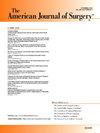Practice variations, trends, and outcomes of drain use in thyroidectomy: A NSQIP study
IF 2.7
3区 医学
Q1 SURGERY
引用次数: 0
Abstract
Background
The benefit of drains remains unclear and variable among thyroid surgeons. This study examines the utility and trend in drain use after thyroidectomy.
Method
This is a retrospective cross-sectional study utilizing a pooled sample of thyroidectomy patients from the 2016–2019 NSQIP. The impact of drain use on outcomes of interest (rate of postoperative neck hematoma (PNH)–primary outcome, and length-of-stay (LOS)–secondary outcome), as well as year-over-year and practice variations were evaluated using inverse-probability-weighted-regression adjustment and multivariable logistic regression analyses.
Results
Of 24,370 patients, 6673(27.4 %) received drains. The average LOS and PNH rates were 27.3 h and 1.87 %, respectively. Drain use increased year-over-year for concomitant neck dissections (OR = 1.08,p = 0.002). Year-over-year odds of drain use trended down across specialties (OR = 0.96,p = 0.005); however, ENT used drains more frequently than General Surgeons (RR = 3.06, 95%CI = 2.91–3.22). Drains were associated with longer LOS (mean-difference = 9.6hrs, 95%CI 8.51–10.62) with no effect on PNH rates (RR = 0.96,p < 0.05).
Conclusion
Drain use is decreasing, but practice variations across specialties persist. Post-thyroidectomy drain use was associated with longer LOS with no effect on PNHR.
甲状腺切除术中引流管使用的实践差异、趋势和结果:一项 NSQIP 研究。
背景:甲状腺外科医生对引流管的益处仍不清楚,且存在差异。本研究探讨了甲状腺切除术后使用引流管的效用和趋势:这是一项回顾性横断面研究,采用的是 2016-2019 NSQIP 中甲状腺切除术患者的汇总样本。使用反概率加权回归调整和多变量逻辑回归分析评估了引流管的使用对相关结果(术后颈部血肿率(PNH)--主要结果和住院时间(LOS)--次要结果)的影响,以及同比和实践的变化:在 24,370 名患者中,有 6673 人(27.4%)接受了引流术。平均住院时间和 PNH 发生率分别为 27.3 小时和 1.87%。同时发生颈部解剖的患者使用引流管的比例逐年增加(OR = 1.08,P = 0.002)。各专科使用引流管的同比几率呈下降趋势(OR = 0.96,p = 0.005);然而,耳鼻喉科比普外科更常使用引流管(RR = 3.06, 95%CI = 2.91-3.22)。引流管与较长的 LOS 相关(平均差异 = 9.6 小时,95%CI = 8.51-10.62),但对 PNH 的发生率没有影响(RR = 0.96,P 结论:引流管的使用正在减少,但对 PNH 的发生率没有影响(RR = 0.96,P = 0.005):引流管的使用正在减少,但各专科之间的实践差异依然存在。甲状腺切除术后引流管的使用与较长的LOS有关,但对PNHR没有影响。
本文章由计算机程序翻译,如有差异,请以英文原文为准。
求助全文
约1分钟内获得全文
求助全文
来源期刊
CiteScore
5.00
自引率
6.70%
发文量
570
审稿时长
56 days
期刊介绍:
The American Journal of Surgery® is a peer-reviewed journal designed for the general surgeon who performs abdominal, cancer, vascular, head and neck, breast, colorectal, and other forms of surgery. AJS is the official journal of 7 major surgical societies* and publishes their official papers as well as independently submitted clinical studies, editorials, reviews, brief reports, correspondence and book reviews.

 求助内容:
求助内容: 应助结果提醒方式:
应助结果提醒方式:


